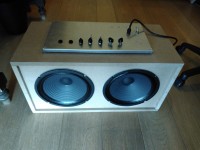JFET guitar amp

Single channel, clean/crunch/distortion amp run by JFETs !
This project describes a small guitar power amp, built around four J112 JFET's.
(https://www.conrad.be/nl/p/on-semiconductor-transistor-bjt-discreet-j112-to-92-tape-3027573.html)
JFETs are well known to produce a very nice "tube" like distortion, so they are perfect to play around with.
My goal is to produce a variety of "sounds" with this amp: from "clean" trough "crunch" all the way to "distortion". I choose for a single channel approach this time.
See my schematic "JFET guitar amp V1.0.pdf"
Q1 is the input amplifier, which amplifies the guitar signal about 10 times.
RV1 is the input gain volume control.
Q2 amplifies the signal around 2.5 times, and is needed to drive the tone control. This is a one knob tone control, built around a lowpass filter (R8 C7) and a highpass filter (C6 R9) that are mixed with RV2. Setting the potmeter more towards "lowpass" gives a less high tone and vice versa.
Q3 and Q4 are two identical tone shaping stages. SW2a (SW3a) adds a boost in the gain by adding source capacitor C10 (C16). To balance the signal level compared to "non boost" mode I use SW2b (SW3b) to add extra attenuation resistors R17 (R18) in the signal path.
Q3 (Q4) have also a BIAS potmeter to adjust the working point of each JFET. With this control you can adjust the symetry of the signal, producing a more "crunchy" type of sound when set off centre.
With these two stages, you can play around and try and find the right tone you like!
As power amplifier, I use a standard KEMO module: this time the KEMO M033N. (https://www.conrad.be/nl/p/kemo-m033n-mono-versterker-module-9-v-dc-12-v-dc-18-v-dc-20-v-dc-18-w-4-130082.html)
They are cheap, reliable, and if you don't overdrive them, they work perfect!
RV5 is the output volume control. As you can see, the signal is well attenuated, because the KEMO module has an input sensitivity of 100mV max !!
I use 2 Celestion Ten-30 speakers of 8ohm in parallel, they sound great and are pretty cheap!
The powersupply is pretty straight forward, transformer/rectifier and 15V regulator.
I think this is a nice sounding amplifier, with plenty of power due to the 4 ohm dual speaker setup.
The tone shaping is a non standard approach, that gives a lot of options to find your perfect flavour.
The use of JFETS avoids the complexity of tubes with an equal (or even better) sound quality !!
I have add a few scope images of different signal shapes that are possible with both tone shaping stages.
Also some images of my prototype amp!
PCB design might follow soon....
Have fun!!
(https://www.conrad.be/nl/p/on-semiconductor-transistor-bjt-discreet-j112-to-92-tape-3027573.html)
JFETs are well known to produce a very nice "tube" like distortion, so they are perfect to play around with.
My goal is to produce a variety of "sounds" with this amp: from "clean" trough "crunch" all the way to "distortion". I choose for a single channel approach this time.
See my schematic "JFET guitar amp V1.0.pdf"
Q1 is the input amplifier, which amplifies the guitar signal about 10 times.
RV1 is the input gain volume control.
Q2 amplifies the signal around 2.5 times, and is needed to drive the tone control. This is a one knob tone control, built around a lowpass filter (R8 C7) and a highpass filter (C6 R9) that are mixed with RV2. Setting the potmeter more towards "lowpass" gives a less high tone and vice versa.
Q3 and Q4 are two identical tone shaping stages. SW2a (SW3a) adds a boost in the gain by adding source capacitor C10 (C16). To balance the signal level compared to "non boost" mode I use SW2b (SW3b) to add extra attenuation resistors R17 (R18) in the signal path.
Q3 (Q4) have also a BIAS potmeter to adjust the working point of each JFET. With this control you can adjust the symetry of the signal, producing a more "crunchy" type of sound when set off centre.
With these two stages, you can play around and try and find the right tone you like!
As power amplifier, I use a standard KEMO module: this time the KEMO M033N. (https://www.conrad.be/nl/p/kemo-m033n-mono-versterker-module-9-v-dc-12-v-dc-18-v-dc-20-v-dc-18-w-4-130082.html)
They are cheap, reliable, and if you don't overdrive them, they work perfect!
RV5 is the output volume control. As you can see, the signal is well attenuated, because the KEMO module has an input sensitivity of 100mV max !!
I use 2 Celestion Ten-30 speakers of 8ohm in parallel, they sound great and are pretty cheap!
The powersupply is pretty straight forward, transformer/rectifier and 15V regulator.
I think this is a nice sounding amplifier, with plenty of power due to the 4 ohm dual speaker setup.
The tone shaping is a non standard approach, that gives a lot of options to find your perfect flavour.
The use of JFETS avoids the complexity of tubes with an equal (or even better) sound quality !!
I have add a few scope images of different signal shapes that are possible with both tone shaping stages.
Also some images of my prototype amp!
PCB design might follow soon....
Have fun!!



Discussie (0 opmerking(en))